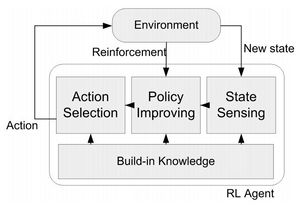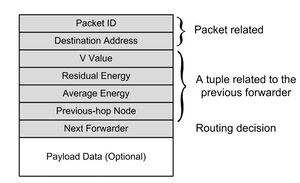QELAR
From NUEESS
(→Downloads) |
(→Packet Format) |
||
| Line 46: | Line 46: | ||
[[Image: pf.jpg|thumb|300px]] | [[Image: pf.jpg|thumb|300px]] | ||
| - | The packet header includes three parts: | + | The packet header includes three parts: two packet-related fields, a tuple related to the previous forwarder and the routing decision made by the previous forwarder. |
The two packet-related field are | The two packet-related field are | ||
Revision as of 14:24, 24 May 2011
Contents |
Overview
QELAR is a Q-learning-based energy-efficent and lifetime-aware routing protocol. It is designed to address various issues related to underwater acoustic sensor networks (UW-ASNs). By learning the environment and evaluating an action-value function (Q-value), which gives the expected reward of taking an action in a given state, the distributed learning agent is able to make a decision automatically.
We find that Q-learning is very suitable in UW-ASNs in the following ways:
- Low Overhead. Nodes only keep the routing information of their direct neighbor nodes which is a small subset of the network. The routing information is updated by one-hop broadcasts rather than flooding.
- Dynamic Network Topology. Topology changes happen frequently in the harsh underwater environment. Without GPS available underwater, QELAR learns from the network environment and allows a fast adaptation to the current network topology.
- Load Balance. QELAR takes node energy into consideration in Q-learning, so that alternative paths can be chosen to use network nodes in a fair manner, in order to avoid 'hot spots' in the network.
- General Framework. Q-learning is a framework that can be easily extended. We can easily integrate other factors such as end-to-end delay and node density for extension and can balance all the factors according to our need by tuning the parameters in the reward function.
Design
Q-learning
Q-learning is one type of Reinforcement Learning algorithms, by which a system can learn to achieve a goal in control problems based on its experience. An agent in RL chooses actions according to the current state of a system and the reinforcement it receives from the environment. Most RL algorithms are based on estimating value functions, functions of states (or of state-action pairs), which evaluate how good it is for the agent to be in a given state (or how good it is to perform an action in a given state).
We denote the value of taking an action a in a state s as Q(s,a), and the direct reward of taking such an action as r(s,a). The optimal Q(s,a) can be approximated by the following iteration:
where s' is the next state, α and γ is the learning rate and future discount, respectively.
Reward Function
The reward function in Q-learning determines the behavior of the learning agent. In QELAR, we consider the following three rewards:
- The penalty of forwarding a packet. Forwarding a packet consumes energy, occupies channel bandwidth, and contributes to the delay. Therefore forwarding a packet should always receive a negative reward, which is − g.
- Residual energy. Lower reward should be given if the residual energy of either the sender or the receiver is low. Therefore, forwarding to a packet to a node with low residual energy can be avoided. The reward related to residual energy of Node n is defined as
- Energy distribution. Energy distribution should also be considered to ensure that the energy is distributed evenly among a group of sensor nodes, which includes the node n that holds a packet and all its direct neighbors in the transmission range. It is defined as
where  is the average residual energy in Node n's group.
is the average residual energy in Node n's group.
In summary, the reward that Node n forwards a packet to Node m is
where α1 and α2 are the constant weights that can be adjusted.
Packet Format
The packet header includes three parts: two packet-related fields, a tuple related to the previous forwarder and the routing decision made by the previous forwarder.
The two packet-related field are
- Packet ID, the unique ID of the packet, and
- Destination Address, the address where the packet should be ultimately send to.
Before forwarding the packet, a node should put its own information in the tuple:
- V Value, the current V value,
- Residual Energy, the current residual energy,
- Average Energy, the average residual energy in its local group, and
- Previous-hop Node, the ID or address of the previous hop.
The last field Next Forwarder indicates that the ID of the node eligible to be the next forwarder.
Related Publications
- T. Hu and Y. Fei, “QELAR: A machine-learning-based adaptive routing protocol for energy efficient and lifetime-extended underwater sensor networks,” IEEE Trans. on Mobile Computing, vol. 9, no. 6, June 2010.
- T. Hu and Y. Fei, “QELAR - A Q-learning-based energy-efficient and lifetime-aware routing protocol for underwater sensor networks,” in IEEE Int. Performance Computing & Communications Conf., Dec. 2008.
Simulation Tools
The simulation tool is originally developed on NS2, and is currently being moved to OMNet++.
Downloads
The simulation tool of QELAR is built based on
The QELAR tool is currently being ported to the platform of OMNet++. It is coming soon.
Installation Guide
Will be provided upon release.
User Guide
Will be provided upon release.
| Whos here now: Members 0 Guests 0 Bots & Crawlers 7 |

![Q(s,a)\leftarrow(1-\alpha)Q(s,a)+\alpha\left[r(s,a)+\gamma\max_aQ(s',a)\right],](/nueess/images/math/b/c/b/bcbff2bebe87680f3251621f179ac9e2.png)


![r(n,a,m)=-g-\alpha_1\left[c(n)+c(m)\right]+\alpha_2\left[d(n)+d(m)\right],](/nueess/images/math/f/5/6/f567ebc5bea4476b23decb4b96028ab2.png)

